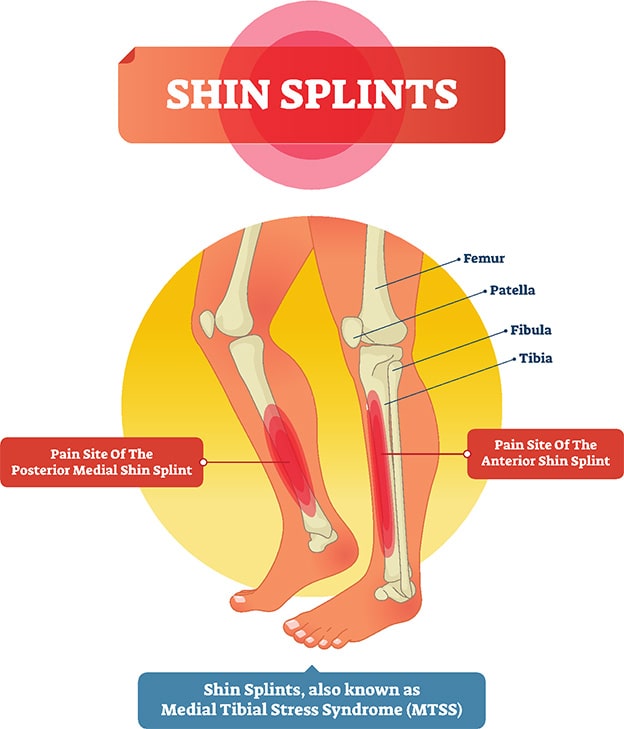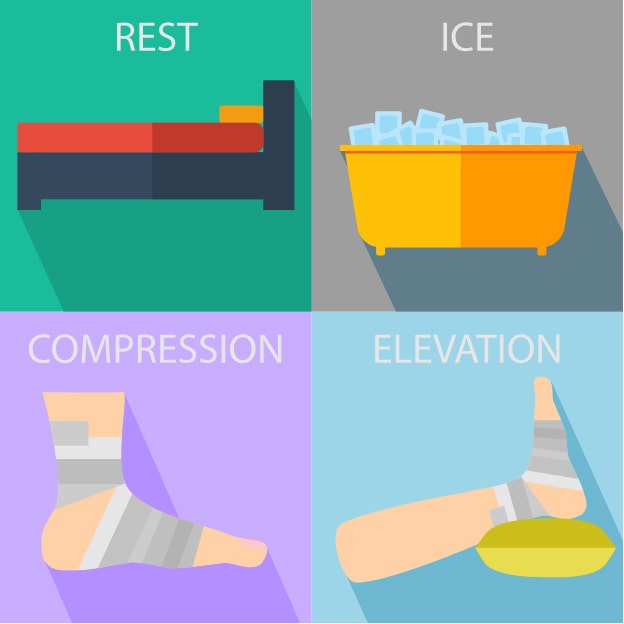Make an Appointment
Curious to know - what are shin splints and what can you do about them? Come aboard.
Shin splints are almost like sprains and other injuries but they refer to a variety of pains that you get in your shin.
Shin splints are medically known as the Medial Tibial Stress Syndrome (MTSS). It is most common among soldiers and runners. However, many different kinds of athletes can experience shin splints.
For example, MTSS can result from sports like basketball, tennis, football, badminton, dancing, and other sports that involve a lot of running and jumping. They can also occur from walking in worn-out shoes for longer than usual.
Although shin splints are incredibly common, you might not know how to treat them properly or prevent them from happening altogether. We’re here to change that.
What Are Shin Splints?
Shin splints are characterised by pain along the front of your lower leg near your shin bone. Shin splints are a common overuse injury that can be treated with rest, ice, stretching, and physiotherapy.
Shin splints are common among:
- Runners
- Dancers
- Athletes in sports that require a lot of running on hard surfaces like tennis
Below, we’re going over what causes shin splints, how to prevent and stop shin splints, and physio treatment for shin splints.

What Causes Shin Splints?
The major reason why shin splints occur is that the tendons and muscles are constantly rubbed with the tibia or shin bone. In other words, you can describe this as a friction burn. However, it’s a bit more intense.
More anatomical responses are included in too. But, at the end of the day, all of this overuse is what causes pain in the shin area.
Causes of shin splints include:
- Running for long periods on hard surfaces
- Overexertion of your lower leg muscles
- Not stretching adequately
- Tight calf muscles
- Inappropriate, uncomfortable, or worn-out footwear
- Increasing your activity level too much and too quickly
- Flat feet or high arches
- Weak hips, ankles, or core muscles
If you experience pain in your shin area while working out, don’t continue. It will only bother you more. The splints will last longer when you work out and push through the pain.
How Shin Splints Occur?
There are a variety of reasons for shin splints. Running for long periods on a hard surface has a constant impact on the body which leads to inflammation in the lower muscles of the legs. Exertion on your lower leg muscle can also be the reason for shin splints.
Do you feel your calves are tighter than usual?
If so, then it could be a sign of a potential MTSS. Tight calves mean that the inner leg muscles are working extra hard to lift the foot during running or walking. This forces too much resistance on the calves and could sometimes become the reason for shin splints.
Wearing inappropriate or uncomfortable footwear should also be avoided. If your new training shoes are causing pain in your shins, then reconsider wearing them again. Trainers that are worn out should be replaced with new ones in order to avoid any such circumstances.
Shin Splint Symptoms
The most obvious symptom of shin splints is pain in the front of your lower leg near your shin bone between your knee and ankle. However, there’s a bit more to it than that.
Shin splint symptoms include:
- Pain along your tibia (shin bone)
- Reduced flexibility in your lower leg
- Weakness in your lower leg
- Pain when pressure is applied to the shin
- Pain near your shin during activities like running, jogging, jumping, and sprinting
How to Prevent Shin Splints
Runners tend to experience shin splints more often than other kinds of athletes. However, dancers, military recruits, and players of sports involving lots of running can also suffer.
Here are a few tips to help you prevent shin splints if you fall into one of those categories.
- Wear shoes that fit properly
- Invest in shoe inserts if you have flat feet or high arches
- See a physio to perfect your running stride
- Replace your shoes often
- Gradually build up your fitness level to prevent injury
- Embrace cross-training to avoid overusing the muscles in your lower legs
- Try shoes or inserts with shock absorption
- Be sure to always stretch before and after a workout or play
- Strengthen your hips, ankles, and core muscles
- Run and jump on softer surfaces like grass or raised floors
How Can I Stop Shin Splints?
If you’re experiencing a lot of pain in your shins, here are a few ways to treat shin splints:
- RICE Method (rest, ice, compression, elevation)
- Lower leg calf massage
- Strapping or taping
- Working with a physio
- Some stretching
The most common solution anybody would give you is to consult a sports injury therapist. A thorough examination on the injury can prove well whether it is an MTSS you are suffering with or something else.
Still, with the RICE method, shin splints often go away on their own.
Rest your legs for a few days if you start to notice shin splint pain. It’s not worth it to push through and continue running or working out. It’ll only draw out the inevitable.
While you’re resting, ice your legs for 20 minutes at a time, three to four times per day. Ice reduces swelling and pain. Plus, once you remove the ice it creates a warming effect. Do not use heat on your shin splits and avoid icing your skin directly. Always use a towel around ice or ice packs to protect your skin.
Compression socks, wraps, and taping can also help with shin splints. The compression reduces swelling and provides additional support. However, be sure not to apply the compression too tightly as this can cut off circulation. You need that blood flow in order to heal. If your leg feels numb or tingly, you’ve wrapped it too tight.
Finally, to complete the RICE method you’ll need to elevate your shin above your heart. Doing so while lying down helps reduce swelling and inflammation. You can elevate your shin at the same time as you ice the area.
However, if you’re experiencing extreme shin pain, the RICE method may not be enough. In that case, it’s highly advised to seek professional help from your doctor or a physiotherapist.
Stretching can also be useful for treating shin splints. However, if you feel ANY pain during lower leg stretches, do not continue. Again, seeking the help of a physio for shin splints is essential to ensuring the safety of the treatment.

Can Physio Help Shin Splints?
Getting examined by a physio helps you understand the situation better so that you can learn how to cope up with it. During your physio sessions for shin splints, you’ll likely be treated with:
- Lower leg massages
- Strapping or taping
- Strengthening exercises for weak ankles, hips, or core muscles
- Customised advice to care for your shin split injury
Massage of your lower leg muscles helps to relax the muscles and relieve pain in your shins. Since shin splints can be caused by tight calf muscles, your physio can assess whether this is the reason for your shin splints and offer a professional massage.
Strapping or taping can also help in reducing the pain. There’s a specific way to strap and tape your shins to relieve pain which your physio will go over with you. You will also be given advice, tips, and suggestions to follow to take care of your shin splints properly.
Every physiotherapist has their own treatment plans and each one of them is going to have a different process for treating shin splints.
Additionally, each treatment plan is completely customised for your situation and needs. Just another reason seeing a physio can help with shin splints more effectively than doing so on your own.
While you’re being treated for shin splints by a physio, make sure you are taking ample rest as well. Again, pushing through the pain will only make things worse.
--
MTSS can be a wicked nightmare if mistreated. Dealing with it can put pressure on you and aggravate your mental health. Especially if you’re a passionate or professional athlete, making sure you get proper treatment for your shin splints is essential. Train safely and don’t overburden yourself.
Are your shin splints driving you up the wall? There is no need to put up with painful shin splints and let it deter from your physical activates. Find your local Physio Inq Physiotherapist get yourself sorted and alleviate your shin splints today.
Date Published: Monday, December 21, 2020
Need to get into direct contact with ur Client Services team? We're all ears. Call our team directly on 1300 731 733
